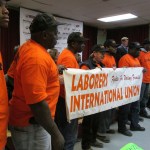Occupational health
Cracking down on deadbeat bosses: Wage theft victory a milestone in Chicago's worker center movement
by Kim Krisberg
For Angel Nava, Chicago's newly adopted wage theft ordinance is particularly personal.
Until recently, Nava had worked at the same car wash business in Chicago's Uptown neighborhood for 14 years. The 55-year-old employee did it all — washing, detailing, buffing — for about 50 hours each week. Then, his boss decided to stop paying overtime.
In fact, Nava didn't receive the overtime he was owed for the last four years he worked at the car wash. He told me (though a translator) that none of his co-workers were receiving overtime either — "everyone was very upset." Nava said he…
A funny thing happened when representatives of U.S. foundries met on March 12 with White House officials to complain about a not-yet-proposed worker safety regulation. The industry group seemed to forget that the targets of their complaints are contained in their own best practices publication.
The American Foundry Society (AFS) requested the meeting with the Office of Management and Budget's (OMB) Office of Information and Regulatory Affairs (OIRA) to discuss a draft proposed rule by the Labor Department's OSHA to protect workers exposed to respirable crystalline silica. AFS…
In the Washington Post, Sandra G. Boodman writes about anger management problems in healthcare:
At a critical point in a complex abdominal operation, a surgeon was handed a device that didn’t work because it had been loaded incorrectly by a surgical technician. Furious that she couldn’t use it, the surgeon slammed it down, accidentally breaking the technician’s finger. “I felt pushed beyond my limits,” recalled the surgeon, who was suspended for two weeks and told to attend an anger management course for doctors.
The 2011 incident illuminates a long-festering problem that many hospitals have…
by Kim Krisberg
Texas construction workers who've lost their lives on unsafe worksites may be gone, but they certainly haven't been forgotten. Earlier this week, hundreds of Texas workers and their supporters took to the streets to demand legislators do more to stop preventable injury and death on the job. They took their demands and the stories of fallen workers all the way the halls of the state capitol.
Just two days ago, workers from every corner of the Lone Star state made their way to Austin to take part in the Day of the Fallen, a day of action to memorialize construction workers…
by Kim Krisberg
For many migrant farmworkers, the health risks don't stop at the end of the workday. After long, arduous hours in the field, where workers face risks ranging from tractor accidents and musculoskeletal injuries to pesticide exposure and heat stroke, many will return to a home that also poses dangers to their well-being. And quite ironically for a group of workers that harvests our nation's food, one of those housing risks is poor cooking and eating facilities.
A group of researchers and advocates recently decided to take a closer look at such facilities among migrant farmworker…
by Kim Krisberg
After nearly three decades as a USDA food safety inspector, Stan Painter tells me he now feels like "window dressing standing at the end of the line as product whizzes by."
Painter, a poultry inspector with the Food Safety and Inspection Service (FSIS) stationed in the northeast corner of Alabama in the town of Collinsville, is a first-hand witness to USDA's recently proposed rule to speed up poultry inspection lines while simultaneously reducing the number of federal food inspectors and turning over much of the food safety oversight to plant employees, who could have little…
Imagine an organization that is given 90 days to complete a task, but after two years still hasn't finished the job. When you ask them 'what's taking so long?' or 'when we'll you be done?' they respond with 'no comment.'
That's the frustrating situation encountered by the U.S. public health and worker safety community when it comes to the Obama Administration and a proposed rule to protect workers from respirable crystalline silica. The proposed regulation would potentially affect workers involved in stonecutting, sandblasting, tuckpointing, brickmaking, foundries, and…
by Kim Krisberg
Texas may boast a booming construction sector, but a deeper look reveals an industry fraught with wage theft, payroll fraud, frighteningly lax safety standards, and preventable injury and death. In reality, worker advocates say such conditions are far from the exception — instead, they've become the norm.
Such conditions were chronicled in a new in-depth report released earlier this week. Researchers, who surveyed nearly 1,200 construction workers in Dallas, San Antonio, Houston, Austin and El Paso, found that one in five construction workers experienced a workplace injury…
[Updated below (6/24/2013)]
The Huffington Post's Dave Jamieson has a story today from the Kentucky coal fields that has my head shaking in disbelief. Reuben Shemwell, 32, says he was fired by Armstrong Coal after complaining about safety problems, including asphyxiation hazards and inappropriate respirators. As provided by the federal Mine Act (Section 105(c)), Shemwell filed a complaint with the U.S. Labor Department's MSHA for wrongful discharge. Now he finds himself being sued by his former employer in Kentucky state court. Armstrong Coal claims that Shemwell…
In the month's preceding the deadly explosion in April 2010 that killed 29 coal miners, Massey Energy's Upper Big Branch (UBB) mine had racked up hundreds of serious violations of safety standards. In 2009 alone, this included 48 orders from federal mine inspectors to withdraw workers from the UBB mine because of dangerous conditions. But Massey knew how to game the system. Mine managers would make a couple tweaks, correct the immediate problem, and it was back to mining coal. usually within an hour or so. There was no real consequence for their or other mine…
by Kim Krisberg
"To know you participated in building something in your city — it's just an experience, you know?"
Those are words from Austin, Texas, native Christopher McDavid, 22, a graduate of the city's newly established Construction Career Center. During his time at the center, McDavid got certified in flagger safety (flaggers direct the safe passage of traffic through construction areas), first aid and CPR, and basic concrete work and received his OSHA 10 certification, which he said "has opened my eyes to actually see the things that can be harmful to me."
Now, McDavid is looking for…
In the weeks ahead, President Obama will announce his pick to replace Hilda Solis as the 26th Secretary of Labor. It's the Cabinet-level position with the resources and best platform to promote strong policies for the benefit of U.S. workers----from fair, living wages and safe working conditions, to job training and family leave benefits. I hope the President's nominee takes the time to read "At the company's mercy: Protecting contingent workers from unsafe working conditions," a new report by the Center for Progressive Reform (CPR). It describes how work arrangements…
by Kim Krisberg
Dr. Paul Demers says he frequently finds himself having to make the case for why studying workplace exposures to carcinogens is important. Oftentimes, he says, people believe such occupational dangers are a thing of the past.
"A lot of people are still developing cancer and dying from cancer due to workplace exposures, but only a small fraction of those are compensated, so people may think the magnitude of this problem is small," said Demers, director of the Occupational Cancer Research Centre in Ontario, Canada. "I wanted to have better data."
And in just a few years, he will…
Secretary of Labor Hilda Solis has announced that she is resigning her position in the Obama administration. Chris Hamby of the Center for Public Integrity looks back at Solis's tenure at the Department of Labor:
Labor advocates credit her with restoring the department’s commitment to protecting workers, particularly vulnerable populations, and bringing stronger enforcement of worker safety laws. During her tenure, the Occupational Safety and Health Administration and the Mine Safety and Health Administration expanded initiatives to crack down on repeat violators of safety and health laws –…
by Kim Krisberg
Workers in Travis County, Texas, are celebrating what advocates are calling a landmark victory, after local leaders voted to ensure that economic incentive deals benefit both big business and workers.
In late November, Travis County commissioners approved a new living wage requirement for companies wanting to move into the county and take advantage of the generous tax breaks the region offers to lure new business. The requirement creates a new wage floor of $11 an hour for all employees, including construction workers. On the same day as the county vote, a committee of the…
A recently published case-control study involving more than 2,100 women in southern Ontario, Canada reported a strong association between being employed in the automotive plastics industry and breast cancer. The researchers recruited the 'case' subjects between 2002-2008 among newly diagnosed breast cancer patients and the randomly-selected controls from the same geographic area. The researchers examined a variety of risk factors for breast cancer (e.g., reproductive history, age) and collected data on the women's employment history. Elevated odds of breast cancer were found among…
by Kim Krisberg
The collective experience of domestic workers — house cleaners, nannies and caregivers — often remains hidden from view. For all practical purposes, they work in regulation-free environments without the benefits of labor, wage and health protections or oversight. There are no HR departments in people's homes.
But a new survey released in November has pulled back the curtain on the conditions and experiences domestic workers face, documenting issues such as wage exploitation, preventable on-the-job injuries and the little — if any — power domestic workers have in improving…
By David Ozonoff
Annual Reports from governmental bodies aren’t often significant, much less classic, public health documents. By design they are confined to summaries of an agency’s work over a year’s time and they often don’t even appear until two or more years later. Such was the case for the Annual Report of the Chief Inspector of Factories in Great Britain for the year 1947, which didn’t appear until 1949. Its author was the Chief Inspector himself, a pioneer in occupational health by the name of E. R. A. Merewether.
Originally a general practitioner, Merewether found his way into public…
by Kim Krisberg
It's often said that hard work never hurt anybody. It's a cliché with which occupational health folks and thousands of injured workers would undoubtedly disagree. And while tragic and often preventable physical injuries may be the easiest to see and document, other work-related health risks are much harder to pick up on. One such risk is depression.
Exploring reliable links between work and depression, which is a significant health and economic burden for individuals as well as society, is somewhat murky, as such research is often based on self-reporting methods that can leave…
Shortly after taking office, the head of the Labor Department's Occupational Safety and Health Administration (OSHA) acknowledged the troubling slow pace at which new worker safety regulations are put in place. In a February 2010 speech, David Michaels, PhD, MPH said:
"Some standards have taken more than a decade to establish, and that's not an acceptable response when workers are in danger."
In a March 2010 speech the OSHA chief added:
"Clearly the current system for issuing standards doesn't work well for those it's supposed to benefit - workers. When rulemaking takes years…

